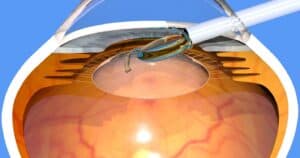LASIK may be the most popular refractive surgery, but it is not the only option available to patients. Clear lens extraction (CLE), sometimes referred to as refractive lens exchange (RLE), is another procedure capable of correcting refractive errors.
CLE involves removing the eye’s natural lens and then replacing it with an intraocular lens (IOL). It is essentially the same procedure used to treat cataract patients, except that it aims to correct nearsightedness and farsightedness rather than cataracts.
Clear Lens Extraction Candidates
 CLE is predominately performed on patients aged 40 or older. Once a person reaches middle age, the lens starts to change, making LASIK a less effective option. Fortunately, an IOL remains effective at any age. Moreover, IOLs are incapable of developing cataracts. Given that cataracts degrade the eyesight of nearly 50% of Americans by the time they are 75, having an IOL can be seen as a preventive measure.
CLE is predominately performed on patients aged 40 or older. Once a person reaches middle age, the lens starts to change, making LASIK a less effective option. Fortunately, an IOL remains effective at any age. Moreover, IOLs are incapable of developing cataracts. Given that cataracts degrade the eyesight of nearly 50% of Americans by the time they are 75, having an IOL can be seen as a preventive measure.
LASIK is also inadvisable for patients who have severe myopia or have weak or misshapen corneas. In most cases, CLE remains a solid option to correct these issues while improving refractive errors.
During a consultation, the eye team at Laser Eye Center of Miami will examine the extent of the patient’s refractive errors as well as other factors to determine whether CLE, LASIK or an alternative procedure is the best way forward.
Clear Lens Extraction Procedure Details
Laser Eye Center of Miami offers multiple types of premium IOLs to best suit the needs of each patient. Ahead of the surgery, the doctor will perform vision tests to determine whether a monofocal lens (which usually improves nearsightedness) or a multifocal lens (which is capable of improving vision at many distances) seems appropriate. The patient’s preference and budget are also factors in this decision.
Just before the surgery, the patient receives anesthetic eye drops to numb the eye and minimize pain during the procedure. After making a small incision on the eye, the surgeon breaks apart the eye’s natural lens and removes it. Then the surgeon carefully inserts an IOL to take the place of the previous lens. This process is often completed in under 30 minutes.
Approximately one week later, the patient returns to the office to have the same procedure performed on the other eye. Each eye is done separately so that the patient never loses his or her entire vision while recovering. Spacing the surgeries also allows time to ensure that there have been no complications.
Refractive Lens Exchange Recovery
 Within a few hours, the effects of the eyedrops fade away, allowing the patient to start seeing better out of the treated eye. However, the quality of vision will fluctuate somewhat for the first few weeks until the final results are achieved.
Within a few hours, the effects of the eyedrops fade away, allowing the patient to start seeing better out of the treated eye. However, the quality of vision will fluctuate somewhat for the first few weeks until the final results are achieved.
Patients should arrange to have a ride home from their surgery, and then commit to rest and relaxation for the first two days of recovery, putting off any strenuous activity including exercise.
Side Effects
Side effects, which are generally minor, include light glare and blurry vision. Some patients experience some discomfort after the anesthesia has worn off, but it can be managed with over-the-counter or prescription pain medication.
Clear Lens Extraction FAQ’s
Who should have clear lens extraction surgery?
Clear lens extraction at Laser Eye Center of Miami can be a great alternative for patients who are not be eligible for LASIK. This surgery may be right for you if:
- You have an extreme case of myopia (nearsightedness) or hyperopia (farsightedness)
- You have age-related farsightedness
- You want to reduce your dependence on glasses and contact lenses
What are the lens options for clear lens extraction?
Monofocal lens: Monofocal lenses are designed to provide clear vision at a single distance. Many patients choose to set their IOLs for distance vision and rely on reading glasses for tasks that require sharp vision up close.
Multifocal lens: This type of IOL allows for clear vision both near and far, with some multifocal lenses even providing intermediate vision correction.
Extended depth-of-focus lens: This type of lens has one corrective zone that provides clear distance and intermediate vision, allowing patients to experience a wide range of clear vision.
Accommodative lens: Accommodative lenses can correct vision at all distances. This lens type responds to the natural movements of the eye muscles to change focus.
Toric lens: Patients with astigmatism may benefit from toric lenses, which contain additional correction for those with the condition.
Light adjustable lens: The light adjustable lens is unique in that it is the only one that can be adjusted post-surgery. It offers patients the flexibility to preview a range of different outcomes before permanently selecting the best one.
How do I decide which lens is right for me?
A key benefit of clear lens extraction is that there are several options available that can effectively correct vision. Because of this, patients may wonder how they should go about choosing the right lens. During your consultation, one of our skilled eye doctors will recommend the IOL that best meets your vision needs.
What refractive issues can clear lens extraction address?
Clear lens extraction is designed to correct nearsightedness, farsightedness, and age-related farsightedness.
What are the long-term results of clear lens extraction?
Clear lens extraction is a safe and effective procedure that offers significant advantages to the patient, including permanent vision correction. You can expect your results to last a lifetime.
What should I expect during recovery?
Recovery from clear lens extraction is typically quick, with many patients experiencing an improvement in vision the same day. Significant vision improvement will be apparent within a few days post-surgery. The minimal downtime associated with the procedure means that you will be able to return to your regular daily activities sooner after surgery.
Will I still need glasses after surgery?
Depending on the IOL used during your clear lens extraction, you may need to use glasses during some activities that require clear vision at certain ranges. However, most patients can enjoy an overall reduced dependence on glasses and contact lenses after having the procedure.
Why should I choose Laser Eye Center of Miami for my clear lens extraction?
The experts at Laser Eye Center of Miami have extensive experience restoring clear vision in many satisfied patients. Dr. Lazcano and Dr. Awad prioritize patient safety, comfort, and satisfaction at all times and are dedicated, along with their skilled staff, to restoring your vision, protecting the health of your eyes, and improving your quality of life.
Speak to the Experts at Laser Eye Center of Miami
If you find the prospect of being able to ditch your prescription eyeglasses or contact lenses with a minor surgery to be appealing, then come speak to one of the most respected vision teams in southern Florida. To schedule a consultation, please call (305) 443-4733.






